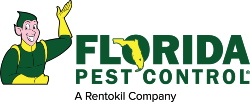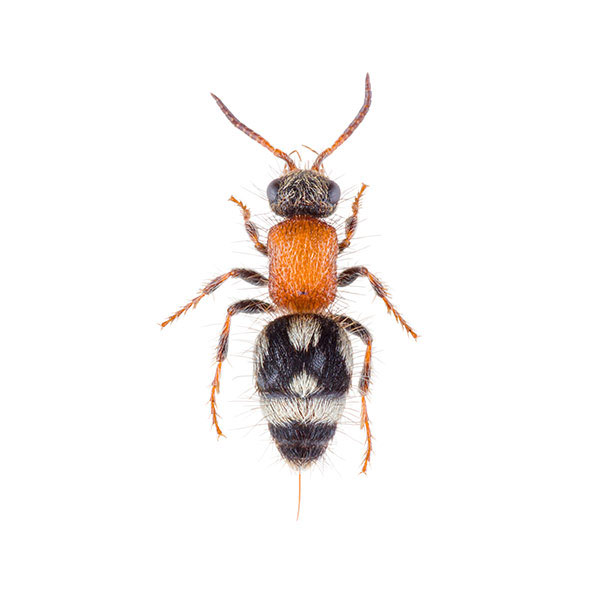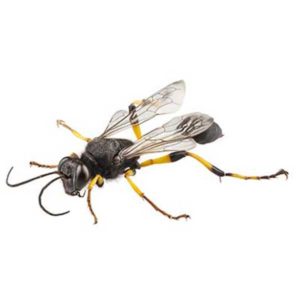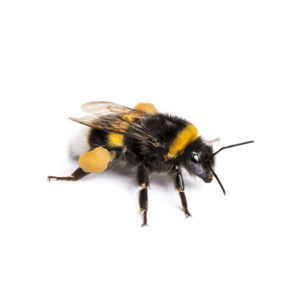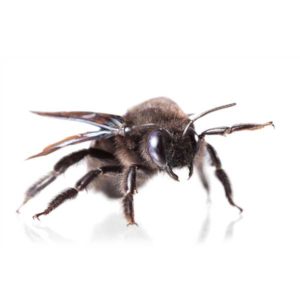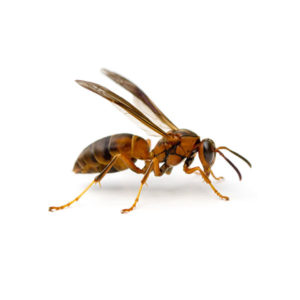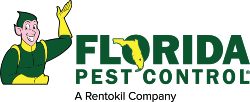Velvet Ant Wasps in Florida
Commonly referred to as the red velvet ant or cow killer ant, the velvet ant (Dasymutilla occidentalis) is actually a solitary wasp belonging to the family Mutillidae. Due to a painful sting, tough outer skeleton, and foul-smelling chemical excretions, it appears that the velvet ant does not have any predators.
What Do Velvet Ant Wasps Look Like?
Velvet ant wasps get their name due to the fuzzy velvet appearance of females, which are wingless and often brightly colored. Their bright colors are actually a signal warning predators to stay away.
Female velvet ants are wingless and have a hard exoskeleton, while males have wings and are often mistaken for bees or other wasps. Females are equipped with a long, sharp stinger, which is actually a modified ovipositor (a tube used for both defense and laying eggs). Adults grow up to an inch long, making them one of the larger solitary wasps in Florida.
Velvet ant wasps are just one of the many species of stinging insects in Florida.
Signs of a Velvet Ant Wasp Infestation
Velvet ants don’t live in colonies like other wasps, but seeing a few in your yard or near the nests of other insects could mean there are more nearby. Watch out for these signs:
- Frequent sightings: Seeing multiple velvet ants, especially in sandy or dry areas, may indicate a thriving local population. They are often found in lawns, gardens, and near nesting sites of ground-dwelling bees and wasps.
- Burrow openings in soil – Velvet ants are known to invade the underground nests of other wasps and bees to lay their eggs. If you notice small holes or burrow openings in the soil, they may be using them to access their hosts’ nests.
- High activity in open areas: These wasps prefer dry, sandy areas, so frequent movement in exposed soil, paths, or sparse lawns may be a sign of their presence.
- Painful stings – While they rarely sting unless handled, if you or pets experience painful stings in areas where velvet ants are active, it could indicate their presence. Female velvet ants have a powerful sting, earning them the nickname “cow killers.”
- Increased presence of solitary wasps and bees – Since velvet ants parasitize ground-nesting wasps and bees, a rise in their population could be linked to an increase in the host species in your area.
If you encounter a red velvet ant, exercise caution. Their painful sting can be avoided by leaving them undisturbed. For safe and effective removal of velvet ant wasps, contact the experts at Florida Pest Control. Our team can handle the problem efficiently and help protect your home.
Habitat, Diet, Life Cycle & Behaviors
Understanding the habitat, diet, and behaviors of velvet ant wasps can help you identify them better.
Where Do Velvet Ant Wasps Live?
Velvet ants typically live in warm, sandy environments such as fields, meadows, and open woodlands. They are commonly found in the southern United States, including Florida, where they thrive in dry, sandy soils. The velvet ant wasp is typically seen running around open areas, sometimes erratically, in late summer. They may be seen in lawns or pastures or wandering into buildings. Females usually search for host nests on the ground, especially on bare, sandy soil. Male velvet ants are often found on flowers.
Diet
Velvet ants are external parasites of bees and wasps, taking over their nests in the ground. A few species of velvet ants paralyze flies and beetles. Adult velvet ant wasps feed on nectar and water. Although uncommon, velvet ant wasps occasionally enter structures in search of prey.
Life Cycle
Velvet ants start their life cycle when a female lays an egg inside a host insect’s nest, like a bee or wasp nest. When the velvet ant egg hatches, the larva feeds on the host insect’s larva or pupa. After feeding, the velvet ant pupates in a cocoon inside the host nest. New adults emerge in late spring or early summer to repeat the cycle.
Behaviors
Velvet ant wasps are solitary creatures and don’t live in colonies. Consequently, there are no identifiable nests to treat. They also make a squeaking noise when handled, which is another defense mechanism. Even though they look scary, velvet ants are not aggressive unless provoked.
Are Velvet Ant Wasps Dangerous?
They can be. Although velvet ants are very docile and rarely come into contact with people, the female velvet ant has a very potent and toxic venom. Males cannot sting and are harmless, but the females have an extremely painful sting, as suggested by the name “cow killer” given to some of the larger species.
A sting generally only occurs if they are accidentally stepped on. If a sting does happen, there is the possibility of a severe allergic reaction occurring in some people that will require immediate medical attention. Parents should educate their children to not handle them or touch them. For advice or assistance with velvet ant wasps in your property, contact your local wasp control experts.
How to Get Rid of Velvet Ant Wasps
The safest way to remove velvet ant wasps is to call a professional pest control service. Experts can locate where these wasps are hiding and safely remove them without risking painful stings. If you’re dealing with velvet ant wasps, contact our wasp experts at Florida Pest Control for safe and effective removal.
Velvet Ant Wasp Prevention Tips
Follow these steps to help keep velvet ant wasps away:
- Seal gaps and cracks: Close any openings around your home to stop wasps from entering.
- Keep your yard clean: Remove debris and trim overgrown grass or plants where wasps might hide. Velvet ants thrive in dry, sandy areas, so reducing bare soil by planting grass or ground cover can discourage them.
- Inspect for nests: Regularly check for bee or wasp nests that velvet ants might parasitize.
- Reduce outdoor food sources: Clean up spilled or sugary liquids that might attract insects.
Need Help with Bees, Wasps, or Hornets?
If you have bees, wasps, or hornets around, it’s important to act fast. Insects like velvet ant wasps, yellowjackets and even the honey bee can be dangerous, especially if they feel threatened. Taking quick action can help keep your home and family safe.
Our bee, wasp and hornet exterminators at Florida Pest Control safely remove nests, prevent infestations, and protect your home from all stinging insects. Get your FREE quote today.
Need help with Velvet Ant Wasps?
We'll call you! Leave your information below.
FAQs
Why are velvet ants so hard to kill?
This is due to their tough exoskeleton, which helps protect them from many threats. Additionally, these wasps often stay hidden in the ground, making them harder to spot and remove.
Are velvet ants poisonous?
Velvet ants aren’t poisonous, but their sting is extremely painful. The venom from their sting can cause discomfort and, in rare cases, allergic reactions.
Why are velvet ants called cow killers?
Velvet ants are called “cow killers” because their sting is so painful that it’s said to be able to kill a cow, though this is an exaggeration.
Do velvet ants sting?
Yes, female velvet ants sting. They use their powerful stinger to defend themselves or while hunting for prey, like beetles and other insects.
Do velvet ants live in colonies?
No, velvet ants are solitary wasps. Unlike many other wasp species, they don’t live in colonies and prefer to live alone, especially during the adult stage.
